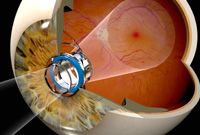Implantable telescope: homing in on central vision
Ninety percent achieved the efficacy endpoint, and, furthermore, over two-thirds of patients improved by at least three lines and one-quarter improved by at least five lines in distance vision

Henry L. Hudson, MD, FACS, vitreoretinal specialist at Retina Centers P.C., and lecturer at the Department of Ophthalmology, University of Arizona, Tucson, USA, recently presented the two-year outcomes data on behalf of the IMT002 Study Group; a 28-centre collaboration in the US, sponsored by the developers of the device, VisionCare Ophthalmic Technologies. The trial completed enrolment of 217 patients (mean age 76 years) in October, 2003.

One-year safety and efficacy outcomes, published in Ophthalmology (2006;113:1987-2001), have shown the prosthetic telescope to be well tolerated and associated with improvement in visual acuity in the vast majority of patients. The majority of patients (90%) met or exceeded the visual acuity end-point (versus 50% target) at the one-year follow-up, however, eleven eyes did not receive the device because of an aborted procedure.
Mean endothelial cell density (ECD) loss at three months was 20% and 25% at 12 months. This decrease in ECD was correlated with post-surgical oedema (p<0.0001), and there was no evidence that endothelial cell loss is accelerated by ongoing endothelial trauma after implantation.
The two-year results support those of the first year and show similar visual acuity outcomes; mean distance best corrected visual acuity (BCVA) improved by 3.2 lines. A gain of three or more lines of distance BCVA was achieved in 59.2% of the implanted eyes compared with 10.3% of the control fellow eyes (p<0.0001). Meanwhile, ECD loss stabilized and was reduced by 2.5% over the second year and, although there were two cases of corneal decompensation in year one, there was no evidence of this in year two.
Quality of life was assessed as a one-year secondary outcome measure using the NEI VFQ-25 and Activities of Daily Living questionnaires. Positive changes were noted in both instruments; mean NEI VFQ-25 scores improved by more than 7 points from baseline (p<0.01) on 7 of 8 relevant subscales. The range of 7 to 14 point improvements in these subscales is in line with what is noted to be clinically meaningful in the AREDS and SST studies. "To patients in their day-to-day lives, visual improvements mean they are less dependent on others, less limited in their activities, more able to visit others and better able to recognize facial expressions," commented Dr Hudson.
